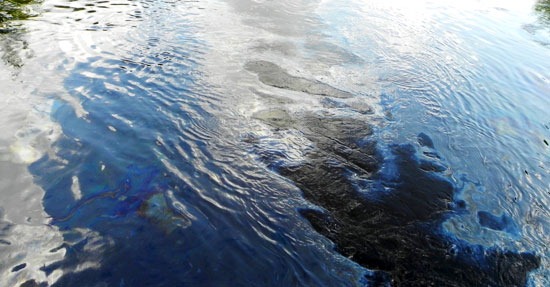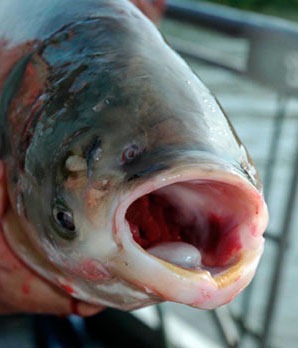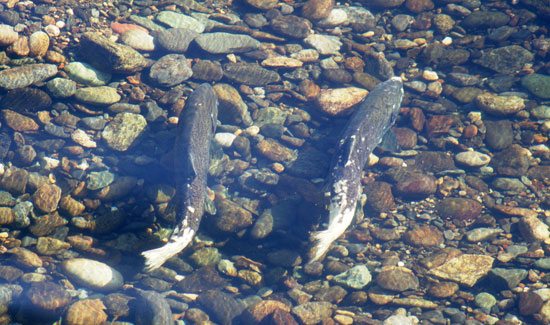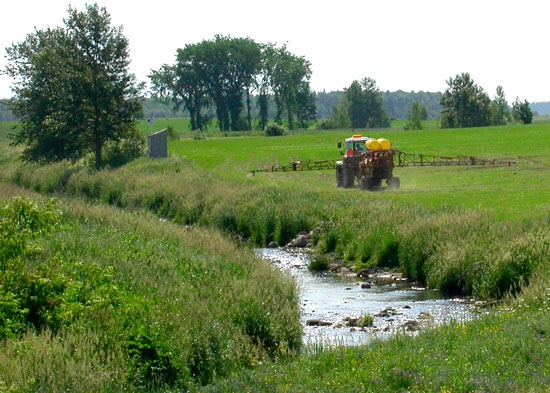One of the Midwest’s largest oil spills sparks fears for Lake Michigan
1
Oil in the Kalamazoo River could reach Lake Michigan by Sunday, meteorologists predict.
Roughly 819,000 gallons of tar sands oil spilled into a tributary of Lake Michigan yesterday, making it one of the Midwest’s largest oil spills ever. A damaged pipeline released the oil into a creek along the Kalamazoo River, which flows into Lake Michigan.
The leak occurred Monday from a 30-inch pipeline that carries approximately 8 million gallons of oil per day from Griffith, Ind., to Sarnia, Ontario and is operated by Houston-based Enbridge Energy Partners.
Skimmers and booms were deployed Tuesday morning at four locations, including the source of the leak in Talmadge Creek and along its mouth where it outflows into the Kalamazoo. But the oil continued to seep past the booms Tuesday night, reports the Battle Creek Enquirer.
Considering the distance of aquifer drinking water sources, as well as the slow speed at which underground water travels, health officials say the spill does not pose an immediate danger to water supplies. However, they have advised people not to touch or swim in the river or eat fish from it.
Environmental Protection Agency officials have been monitoring air quality, with particular concern for unsafe levels of benzene. At least two homes were evacuated yesterday along with another 30 households that have been relocated due to the smell.
The oil has killed fish, coated wildlife with oil, and fouled the shoreline, according to the National Wildlife Federation. The state Department of Agriculture mobilized the State Animal Response Team to help clean animals affected by the spill. The department has also warned producers and homeowners to stop using water from the Kalamazoo River and its tributaries for irrigation or watering.
Oil from the spill could reach Lake Michigan as early as Sunday, according to Wayne Hoepner, a meteorologist for the National Weather Service in Grand Rapids. He added that this estimate could be affected by numerous meteorological and hydrological variables that impact flow rate.
Approximately 200 people, 21 boats, 8 miles of boom, and 30 oil-siphoning trucks are contributing to the cleanup, Enbridge Executive Vice President Steve Wuori told the Enquirer.
“Crews worked through the night on containment, including the use of booms, skimmers and vacuum trucks,” the company said in a statement today.
After touring the area by helicopter yesterday evening, however, Michigan Gov. Jennifer Granholm said more resources should be devoted to cleaning up the spill.
“From my perspective, the response has been anemic,” she said. Granholm has committed the state’s emergency response center to assist with the cleanup.
Many environmental groups have cited this event as an example that oil disasters can strike even in the Great Lakes.
“Gasping fish and birds covered in toxic goo — the Great Lakes have been there already and we’re not going back,” wrote Alliance For The Great Lakes President Joel Brammeier. “We’re spending billions of dollars to dig out from under the spoiled layers of a 20th century legacy. Scheming and speculation that drilling our freshwater coast will bring anything but more ruin to the priceless asset in our backyard does a disservice to the united local, state, federal and binational effort to restore the Great Lakes.”
(Photo galleries of the spill are available from The Detroit Free press here and here.)
Fumes from oil leak creep over Battle Creek [The Detroit Free Press] Granholm slams Enbridge on spreading oil spill [Battle Creek Enquirer] Granholm: Oil cleanup needs more resources [The Detroit Free Press] Dammit, It’s Happening Here [Great Lakes on the Ground] West Michigan Oil Spill: They Said It Couldn’t Happen Here [Alliance For The Great Lakes]
Image Credit: http://greatlakesontheground.com/














[…] gallons of oil per day from Griffith, Ind., to Sarnia, Ontario. The oil spill was considered one of the worst ever in the Midwest and gained the attention of national news media; the cleanup operation has been […]